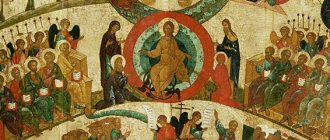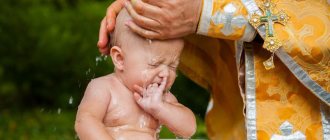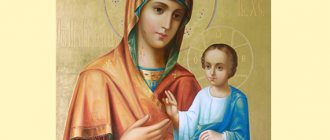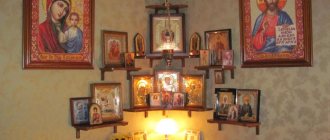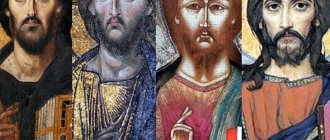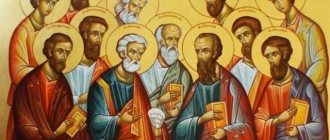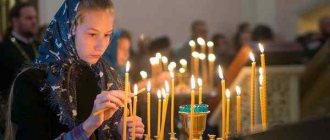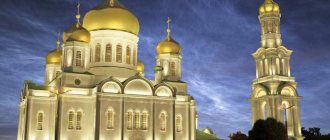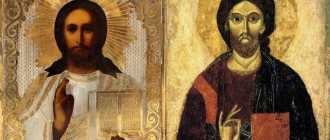For Orthodox Christians, icons are of great importance. Turning to the icon with prayer, an Orthodox person sees in it a kind of mediator between himself and the Lord. From time immemorial, icon painting was considered a deed pleasing to God; It was possible to engage in it only after receiving a blessing and being cleansed of filth through prayer.
Greek icons are among the most ancient, because it was in Greece that its own icon painting tradition aroused admiration for its sophistication and spirituality. Thus, the Greek icons of the Mother of God amaze with their expressiveness: on the faces of the Blessed Virgin there is such detachment, such sorrow that they touch the deepest strings of the soul.
Greek icons - concept and features
Icons are images of God, the Virgin Mary, prophets, saints and righteous people, revered by believers. The tradition of worshiping them arose along with Christianity. According to legend, the first image of the Mother of God was written by the Evangelist Luke on a board from the dining table.
The largest center of icon painting was Byzantium. The shrines created here are called Greek because Greek Orthodox culture predominated in the empire. An important factor for the Byzantine tradition is strict canonicity. A master depicting Divine images subordinates his creativity to a number of rules and laws. Despite this, art has evolved over time.
Researchers divide the history of the religious artistic tradition of Byzantium into different periods. Depending on the political situation in the state, the attitude towards icons also changed - from a complete ban to the flourishing of spiritual painting. If we highlight the most important features of the Greek tradition, we can list the following features:
- strict selection of colors, background (most often, the background was golden), and plot, in accordance with the canon;
- the desire to convey the spiritual world, convention in the depiction of faces, clothes, proportions;
- sankir way of writing, that is, complex modeling of perspective, thanks to which a sense of volume is achieved;
- simplification of the writing style in the Athonite school - softening of lines, more conventional drawing.
Despite periods of political prohibitions and Turkish rule, when images of saints were prohibited, Greek masters managed to preserve unique art to this day. Now this is a very popular area. Many pilgrims and believers seek to purchase icons created on the holy land of Athos.
Modern icons from Greece
Nowadays, the painting of icons has become an important branch of the economy in Greece, since the demand for icons from Greece, which are purchased by Orthodox tourists and pilgrims, does not decrease.
Lists (copies) of icons of the Blessed Virgin located in the monasteries of Athos are especially popular. They are well known not only to Orthodox believers, but also to art connoisseurs. Let us remember that some of these lists were made from icons painted, according to legend, by the Evangelist Luke himself during the life of the Mother of God. Prayer in front of such an icon, even if it is on a list, brings peace and grace to the soul.
( 1 ratings, average: 5.00 out of 5)
Classification
In the sources you can find different methods of classification. But, in most cases, six types are distinguished according to purpose:
- personalized icons depicting the heavenly human intercessor;
- dimensional images that correspond to the height of the child are given for christening;
- family icons depict saints who patronize members of the family;
- wedding images of Jesus Christ and the Virgin Mary are needed for marriage blessings;
- holiday icons are dedicated to solemn dates of the Christian calendar;
- votive images are created in gratitude to God, according to a promise.
In terms of technique, there are two main directions: the canonical and academic style of writing. The first is characterized by strict adherence to the canon, therefore the role of symbolism, features of the facial expressions of holy faces, colors, and clothing elements is great. The second style is distinguished by a more modern interpretation of Christian subjects, this shows the influence of Western European artistic tradition.
The scale of the image can be main (only the face is written), shoulder-length (for example, “The Ardent Eye of the Savior”), half-length (images of the Mother of God with the Child Christ of the Hodegetria type), throne-scale (for example, “Holy Trinity” by Andrei Rublev).
One image can depict one story, for example, “The Baptism of Jesus,” or several stories, as on hagiographic icons with terminals. The latest, multi-subject images include Jerusalemia, which tells about the holy places of the city.
Greek icon-painting workshops producing copies of Byzantine icons are known throughout the world. In our store you can view and purchase Greek icons
from the best manufacturing companies that, following the traditional art of silk-screen printing on canvas, using natural wood and silver frames, produce exact museum copies of icons.
For example, icons from the Greek icon-painting workshop
"Iconotechnics", which began its activities in 1975. From the first years of activity, realizing the importance of its work, the workshop took care of the high quality of its products - the company employs a creative group of people with knowledge and extensive experience in icon painting. The company is the official workshop of the Vatopedi monastery, famous for its collection of blessed images and Orthodox shrines.
And the new series of icons “Angelos” was developed using the best traditions of icon painting and modern technology. The icon painting was made by a famous Greek master using mineral paints on gilded gesso using silk-screen printing with manual processing. The artist’s unique skill allowed him to achieve the finest detail of the Greek icon and a rich color scheme. The frames of all icons are covered with 925 sterling silver sheets, some of the icons are galvanized with gold, coated with colored enamel and inlaid with Swarovski crystals. This series presents copies of icons from museums in Greece and Russia, made in the Byzantine style. All Greek icons are accompanied by a certificate of authenticity with the manufacturer's seal and are packaged in luxurious boxes.
In Greece and on Mount Athos there is a rich collection of Byzantine icon painting, from which one can trace the history of painting icons. The most ancient works date back to the 11th century. In the XIII-XIV centuries. Icons of the Macedonian school with its center in the Greek city of Thessaloniki became widespread. In addition to the fact that these icons are distinguished by realism in the painting of images, the desire to reflect experiences and the inner world, more attention began to be paid to the composition of the background, and landscapes appeared as the background of the icons.
After the fall of Constantinople, the icon became the subject of self-identification of Orthodox Greeks in the Ottoman Empire and one of the means of strengthening them in the faith. Icon painting became a forbidden art; many Greeks suffered martyrdom with icons in their hands. But Holy Mount Athos remained a monastic republic even under the Ottomans, living according to Byzantine rules. Under the conditions of the ban on Orthodoxy in the Ottoman Empire, the monks preserved the traditions of Greek icon painting and continued painting the Athos monasteries.
The center of icon painting in the 15th-17th centuries was Crete, where many artists fled to the protection of the Venetians in 1453. In the early period, the Cretan school was characterized by an ascetic and strict style of iconography and nobility of faces. Subsequently, the artists of the Cretan school were greatly influenced by the culture of the Renaissance. In numerous icon-painting workshops in Crete, up to a thousand icons were painted a year on orders not only from Orthodox monasteries and the Greek diaspora in the Mediterranean, but also from Catholic monasteries and communities in Italy. At the same time, the style of icons for Orthodox and Catholics was very different.
In the 18th century, two trends appeared in Greek icon painting - a return to the traditions of Byzantium and the emergence of a school of masters from Epirus (Ioannina and Kastoria). Byzantine traditions on Athos were revived by the monk Dionysius from Fournos, who lived in one of the cells in Kareas. He painted many frescoes and icons that can now be found in the monasteries of Caracalla, Vatopedi and museums in Greece. Dionysius left behind many students and followers. The works of artists from Epirus were characterized by a strong influence of folk motifs and the inclusion of Baroque elements in their work. But by the end of the 18th century they were supplanted by a more traditional school of master icon painters from Galatista in Chalkidiki. In the 19th century, Greece, with the help of fraternal Russia, freed itself from the Ottoman yoke. The Russian St. Panteleimon Monastery was revived on Athos, and numerous Russian monasteries appeared. Thousands of Russian monks connected their lives with Athos. Among them were dozens of talented icon painters.
Iconography of Jesus Christ on requests : Icon of the Savior, Holy Family, Savior the Wise, Savior Tree of Life, Savior Not Made by Hands, Savior Pantocrator, Savior Merciful, Savior on the Throne Iconography of the Mother of God on requests : Bethlehem, Leaping, Recovering the Lost, Vladimir, All-Tsaritsa, Gerontissa, Glycophilus, It is Worthy to Eat, Iverskaya, Abbess of Mount Athos, Jerusalem, Kazan, Kerkera, Korsun, Burning Bush, Unfading Color, Inexhaustible Chalice, Hodegetria, Joy and Consolation, Veil, Belt of the Most Holy Theotokos, Guidebook, Seven Shots, Sweet Kiss, Passionate, Three-Handed , Tenderness, Soothe My Sorrows Iconography of saints by request : Holy Trinity, Guardian Angel, Archangel Michael, St. George the Victorious, Demetrius of Thessalonica, John of Kronstadt, John the Baptist, Luke Voino-Yasenetsky, Matrona, Nicholas the Wonderworker, Paisius the Holy Mountain, Panteleimon the Healer, Seraphim of Sarov , Sergius of Radonezh, Spyridon of Trimifuntsky Iconography of Holidays by request : Annunciation, Nativity, Last Supper
List of Greek icons of the Virgin Mary
A very important component of the Greek tradition is the image of the Mother of God. Different sources reveal from four to six types of writing of the image of the Virgin Mary:
- Oranta (Praying) - here the Mother of God is depicted standing with her hands raised in prayer. At the chest level of the Heavenly Queen there is a sphere on which Christ is inscribed. This type reflects the moment of the incarnation of God through the Virgin Mary, that is, the pregnant Mother of God.
- Hodegetria (Guide) - has this name because in the half-length image the Mother of God points the viewer with her hand to her son, the Infant Jesus, blessing Her. The Mother of God, as it were, gives spiritual guidance to believers.
- Eleusa (Tenderness) is one of the most touching and gentle types. The appearance of the Heavenly Lady hugging her son, who responds to her affection, is perhaps the most powerful embodiment of the mutual love of a child and a mother, so understandable to every common person. The value of the plot is in conveying the emotional state of Christian sacrificial love.
- Panahranta (The Queen of All) is a majestic image of the Virgin Mary seated on a throne with the Christ Child. Here the Heavenly Lady personifies the power and glory of the Church of the Lord.
- Agiosoritissa (Svyatorachitsa, Chalkopratiyskaya) is the image of the Mother of God, alone praying for the human race. The Virgin Mary without a baby is depicted half-turned, with her hands raised to God. One of the most ancient images of the Mother of God. In addition to this type, there are other images of the Heavenly Queen, without Jesus.
- Akathist icons are a whole series of icons of the Virgin Mary, in the form in which She was glorified in akathists and canons. These images include “The Burning Bush”, “The Inexhaustible Chalice” and others.
Catholic version of the Savior Not Made by Hands
The Catholic version of the appearance of the icon differs significantly from the Orthodox one. This is reflected in the appearance of the image.
During Christ's procession to Calvary, the pious Jewish woman Veronica took pity on him. She gave the Savior a linen handkerchief so that he could wipe his face from sweat and blood.
It is believed that the same scarf is now kept in St. Peter's Basilica in the Vatican. However, in the same Italy, in Manopello, another board of miraculous origin was discovered. Research has shown the similarity of the face of Christ on this relic (by the way, it is visible from both sides and is capable of subtly changing) with the image on the Shroud of Turin.
Nevertheless, most researchers consider the story of Veronica to be simply a beautiful legend.
Description of the image
The miraculous icon of Jesus marked the beginning of an epoch-making iconographic tradition. Icons of this type depict only the face of Jesus, usually surrounded by a solid halo, symbolizing the integrity and unity of the Faith. Sometimes the image is complemented by a background image of a cross.
There are icons where the Savior is surrounded by secondary figures: angels, apostles, saints and medallions depicting the miracles of the Lord.
In the Catholic tradition, dating back to Veronica's Cloak, the halo is usually absent, and a crown of thorns adorns the Savior's brow. In the Russian icon painting tradition, a wreath of thorns is rarely present and is seen as a sign of the influence of the Western school.
In Orthodoxy, the most common are two types of the Savior Not Made by Hands. The first is called Mandylion (“Savior on the Ubrus”) and refers us to the miraculous story of the healing of Avgar. Initially, the Savior’s head was drawn on a light background, symbolizing linen fabric. Later, imitation of fabric folds was added (for example, by the famous icon painter Ushakov).
The second type, Keramidion (“Savior on the Chrepiya”), is little different from the previous one. However, it serves as a reflection of the already mentioned miracle, when the face depicted on the scarf was imprinted on clay. In such images, the face of the Savior is displayed against a darker background; sometimes there is a more or less detailed image of the masonry.
In the Orthodox tradition, the so-called Savior of Wet Brad is very popular. This is another reminder that the Savior wiped his wet face with a handkerchief, as a result of which his beard stuck together into one or two wedge-shaped ends.
